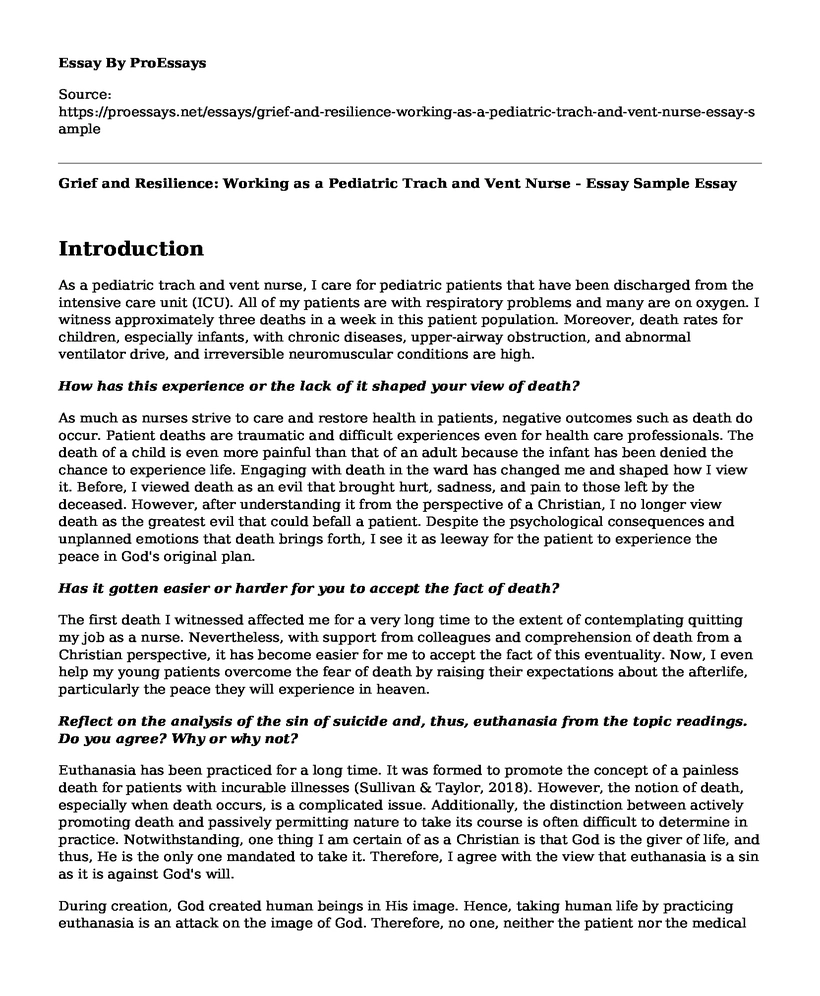Introduction
As a pediatric trach and vent nurse, I care for pediatric patients that have been discharged from the intensive care unit (ICU). All of my patients are with respiratory problems and many are on oxygen. I witness approximately three deaths in a week in this patient population. Moreover, death rates for children, especially infants, with chronic diseases, upper-airway obstruction, and abnormal ventilator drive, and irreversible neuromuscular conditions are high.
How has this experience or the lack of it shaped your view of death?
As much as nurses strive to care and restore health in patients, negative outcomes such as death do occur. Patient deaths are traumatic and difficult experiences even for health care professionals. The death of a child is even more painful than that of an adult because the infant has been denied the chance to experience life. Engaging with death in the ward has changed me and shaped how I view it. Before, I viewed death as an evil that brought hurt, sadness, and pain to those left by the deceased. However, after understanding it from the perspective of a Christian, I no longer view death as the greatest evil that could befall a patient. Despite the psychological consequences and unplanned emotions that death brings forth, I see it as leeway for the patient to experience the peace in God's original plan.
Has it gotten easier or harder for you to accept the fact of death?
The first death I witnessed affected me for a very long time to the extent of contemplating quitting my job as a nurse. Nevertheless, with support from colleagues and comprehension of death from a Christian perspective, it has become easier for me to accept the fact of this eventuality. Now, I even help my young patients overcome the fear of death by raising their expectations about the afterlife, particularly the peace they will experience in heaven.
Reflect on the analysis of the sin of suicide and, thus, euthanasia from the topic readings. Do you agree? Why or why not?
Euthanasia has been practiced for a long time. It was formed to promote the concept of a painless death for patients with incurable illnesses (Sullivan & Taylor, 2018). However, the notion of death, especially when death occurs, is a complicated issue. Additionally, the distinction between actively promoting death and passively permitting nature to take its course is often difficult to determine in practice. Notwithstanding, one thing I am certain of as a Christian is that God is the giver of life, and thus, He is the only one mandated to take it. Therefore, I agree with the view that euthanasia is a sin as it is against God's will.
During creation, God created human beings in His image. Hence, taking human life by practicing euthanasia is an attack on the image of God. Therefore, no one, neither the patient nor the medical professional, has the right to decide when one dies. Also, euthanasia violates the Biblical teachings relating to the sanctity of life. One such teaching is the commandment, "Thou shall not kill." God endowed human beings with the right to life. Taking it away from a person based on ending his or her suffering amounts to murder. Thus, by practicing euthanasia, health care professionals contradict man's purpose in life and forfeit the divine protection that covers human beings.
Finally, God has a reason for everything that happens, even pain and suffering caused by diseases. Although one may view the suffering as unnecessary, God knows better. He makes sure that people experience every season to make them whole. Moreover, as medical practitioners, we cannot know if God will perform a miracle and heal the patient. Therefore, we have no right to decide when patients die. Instead, as supported by Shelly and Miller (2009), we should provide the best quality of care to ensure dying patients do so comfortably and peacefully.
References
Shelly, J. A., & Miller, A. B. (2009). Called to care: A Christian worldview for nursing. InterVarsity Press.
Sullivan, D. M., & Taylor, R. M. (2018). The Ethical Landscape of Assisted Suicide: A Balanced Analysis. Ethics & Medicine, 34(1), 49-3. Retrieved from https://journalofethics.ama-assn.org/article/invoking-shared-beliefs-end-life-decision-making/2013-03
Cite this page
Grief and Resilience: Working as a Pediatric Trach and Vent Nurse - Essay Sample. (2023, May 18). Retrieved from https://proessays.net/essays/grief-and-resilience-working-as-a-pediatric-trach-and-vent-nurse-essay-sample
If you are the original author of this essay and no longer wish to have it published on the ProEssays website, please click below to request its removal:
- Social Change in the Community
- The Therapeutic Use of Narrative Therapy With Oncology Patients Paper Example
- Health Effect of Radiation Essay
- Principles of Professional Ethics for the Intelligence Community to Nursing Code of Ethics
- Organ Donation and Transplantation in Hong Kong
- Paper Example on Handling Hearing and Sight Impaired
- Paper Example on Nurse Practitioners: Improving Public Health & Well-Being







